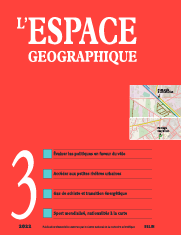

Varia
Freedom of movement by bicycle versus car: A ranking of French cities according to filtered permeability (6 fig.; 2 tabl.)
Filtered permeability (FP), which refers to a city’s capacity to allow movement, is now a key element in understanding the success of cycling cities, assuming that freedom of movement is greater by bicycle than by car. This paper aims to evaluate the level of FP in the 42 most populous cities in France. A FP index, based on three dimensions of network permeability (configuration, connectivity and density), was calculated using OpenStreetMap data. The findings indicate that the FP varies widely from one city to another, with Strasbourg leading the way. Moreover, they reveal a positive correlation between the level of FP and the modal share of cycling, which confirms the relevance of integrating the FP approach into planning practices.
keywords: BICYCLE, BIKEABILITY, CYCLING NETWORK, FILTERED PERMEABILITY, TRANSPORT PLANNING
Assessing hydrosocial connectivity to appreciate the potential use of small urban rivers: A case study of the Croult and Petit Rosne rivers in the Paris area (5 fig.; 4 photo; 1 tabl.)
Projects to restore small urban rivers are on the rise and increasingly respond to a multi-benefit approach, including addressing city dwellers’ need for nature. We intend to provide tools to appreciate the social benefits of such initiatives by measuring the social connectivity of small urban rivers. We first describe the physical configuration of two rivers and their banks in the Paris region before qualifying the potential uses they offer. Our assessment reveals that non-state-owned waterways are highly accessible whereas the six types of river spatial configurations we identified reflect a variety of situations. By putting this typology into perspective using a spatial analysis, we were able to examine more closely the relational potential of such rivers, particularly their restored sections and marginal sectors whose multifunctionalities are not obvious.
keywords: ACCESSIBILITY, ECOLOGICAL RESTORATION, MULTIFUNCTIONALITY, SMALL URBAN RIVER SOCIAL CONNECTIVITY
Energy transition and path dependence: Argentinian Patagonia in a new energy cycle (3 fig.)
Unconventional hydrocarbons could prolong the use of fossil fuels and extend plans for an energy transition to renewables. We analyse this contradiction using the notion of path dependence, by examining the exploitation of unconventional hydrocarbons in the Vaca Muerta shale deposits (Argentinian Patagonia). Gas has taken on a central role in Argentina's energy supply, and this situation affects energy policies. It has led to the development of unconventional hydrocarbons, thereby reconfiguring the Neuquén oil region, while renewable energy projects multiply. Path dependence conditions the energy transition.
keywords: ENERGY TRANSITION, RENEWABLE ENERGY, PATH DEPENDENCE, UNCONVENTIONAL HYDROCARBONS
The globalisation of the international rugby players’ market (3 fig.; 2 tabl.)
The global market of international rugby players has progressively structured itself since the official professionalisation of rugby union in 1995. This market reflects globalisation dialectics, boosted by the lex ovalia and rooted in a neoliberal rationale. The intensification and the multiplication of the flows of athletes illustrate the expansion of this market and the growing connections between the regions of the world. Yet, the fact that certain regions and countries are prioritised for expatriation confirms the fragmentation of the world, with strong asymmetries between national territories, economic inequalities and major cultural differences.
keywords: GLOBALISATION, INEQUALITIES, INTERNATIONAL PLAYERS, MARKET, RUGBY UNION
Lectures
In this issue of l’Espace géographique, you will find critical reviews of the following books
GLON É., SEPÚLVEDA B. (dir.)(2019). Autochtonies. Rennes: Presses universitaires de Rennes, coll. «Essais», 420 p. (Jean-Christophe Gay, IAE Nice, université Côte d’Azur) ISBN: 978-2-7535-8294-1
L’espace géographique 2/22![]()
![]() L’espace géographique 4/22
L’espace géographique 4/22
For subscribe or buy this issue: BELIN
![]() L’Espace géographique: contents
L’Espace géographique: contents
Last modified: December 20, 2023